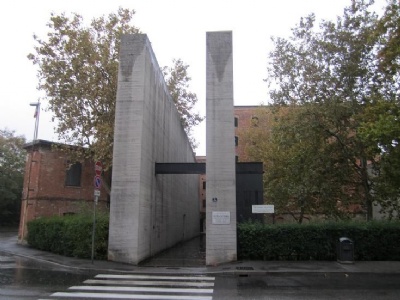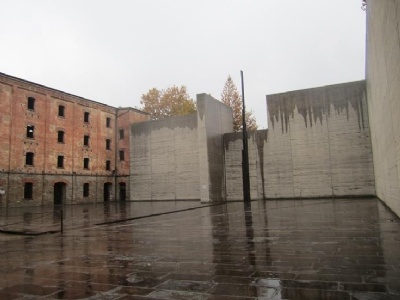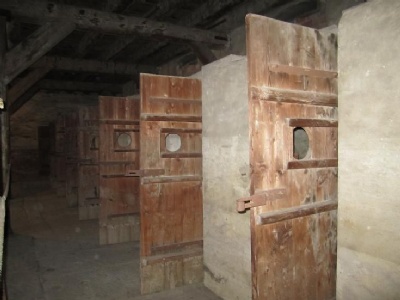Risiera di San Sabba
After Mussolini had been overthrown in September 1943, the Germans occupied Italy and the areas previously occupied by Italy. Immediately the germans begun to disarm the italian army and italian soldiers who did not join the germans were sent to camps. Such a camp was set up in a former rice factory (Risiera di San Sabba) on the outskirts of Trieste. The camp was named Stalag 339 but already in October that year the camp became a police detention camp (Polizeihäftlingslager) for hostages, partisans and Jews who were to be deported to camps in Germany and Poland. Prior to the occupation, Italians were reluctant to surrender jews under their control to the germans, despite repeated requests from the latter. Only in connection with the German occupation did the situation turned for the worse for Jews, who thus risked being deported to the extermination camps in eastern Europe.
In October and November 1943, the Nazis conducted round-ups in Rome, Genoa and Florence, jews from Genoa and Florence were later murdered in Auschwitz. Jews from Friuli were deported via San Sabba to Auschwitz. About 700 Jews were deported from San Sabba to Auschwitz, but some were never deported because they were murdered in the camp. San Sabba was like a small concentration camp in miniature, there was a commandantur, prisoner assembly square, living quarters, penalty cells and workshops where shoes were made. In April 1944, the Nazis established a crematorium in the courtyard to dispose dead bodies. The crematorium was blown up by the retreating germans in late April 1945. Information also claims that the Nazis used a temporary gas wagon to murder prisoners in San Sabba. But this has not been established. The camp was liberated at the end of the war by Yugoslav partisans. 3,000 –,5,000 people died in prison, but most prisoners who ended up in the camp were deported to other camps.
When Operation Reinhardt was completed in Poland in October 1943, several of its leading SS officers were sent to Trieste, including the head of Operation Reinhardt, Odilo Globocnik. He was appointed supreme SS and Police leader of the Operation Zone Adriatisches Küstenland, where Trieste was located. As chief SS and chief of police, he became the supreme controller of San Sabba. Other prominent figures from Poland were Treblinka commandant Franz Stangl, Sobibor commandant Franz Reichleitner, Josef Oberhauser from Belzec (who became commander of San Sabba) and Christian Wirth who was inspector of Operation Reinhardt camps and one of the leading figures from the Nazi euthanasia program between 1939 and 1941.
In total, about 90 veterans from Operation Reinhardt were sent to Trieste. Their experiences from Poland came in handy and one of their tasks was to organize the persecution of the Italian jews. Italy had until the German occupation in September 1943 continuously refused to surrender the jews, but when Italy was occupied, this protection disappeared. However, the veterans from Poland were also tasked with hunting partisans and a unit called Einsatzkommando Reinhardt was set up, which in turn was divided into three commands E 1, E 2 and E 3. Of the documents found after the war, it is known that these commands imprisoned suspected partisans and brought them to San Sabba.
Current status: Partly preserved/demolished (2011).
Address: Giovanni Palatucci 5, 341 46 Trieste.
Get there: Car.
Follow up in books: Arad, Yitzhak: Belzec, Sobibor, Treblinka – The Operation Reinhardt death camps (1987).





In terms of time, the transfer of personnel from Operation Reinhardt fits into the context. The prison uprising in Sobibor in October 1943 can be said to have ended Operation Reinhardt and the staff became available for other assignments. Just as when the euthanasia programme was dissolved in August, 1941, it coincided with the construction of the first extermiantion camps in Poland. Staff from the euthanasia program were then transferred to eastern Poland to participate in the extermination of the Jews. Italy had just been occupied and Himmler needed people with experience of Jewish persecution and this coincided with the liquidation of Operation Reinhardt.
But Himmler may also have had other reasons for transfering prominent people from Operation Reinhardt to Trieste. Adriatisches Küstenland was a dangerous area because of the partisans. The partisans were notorious for their frequent ambush and unwillingness to take any prisoners and the Germans had very good reasons to fear partisans. Neither Globocnik nor Wirth had any previous experience with partisans that made them fit for the task, however, their involvement in the Holocaust was prominent and Himmler might not mind if they disappeared. By moving them to Trieste and hunting partisans, there was a great risk that they would be killed and thus they would not be able to testify about their involvement in Operation Reinhardt. Wirth was killed in an ambush by partisans in May, 1944. Globocnik survived the war and was taken prisoner, but committed suicide in May, 1945.